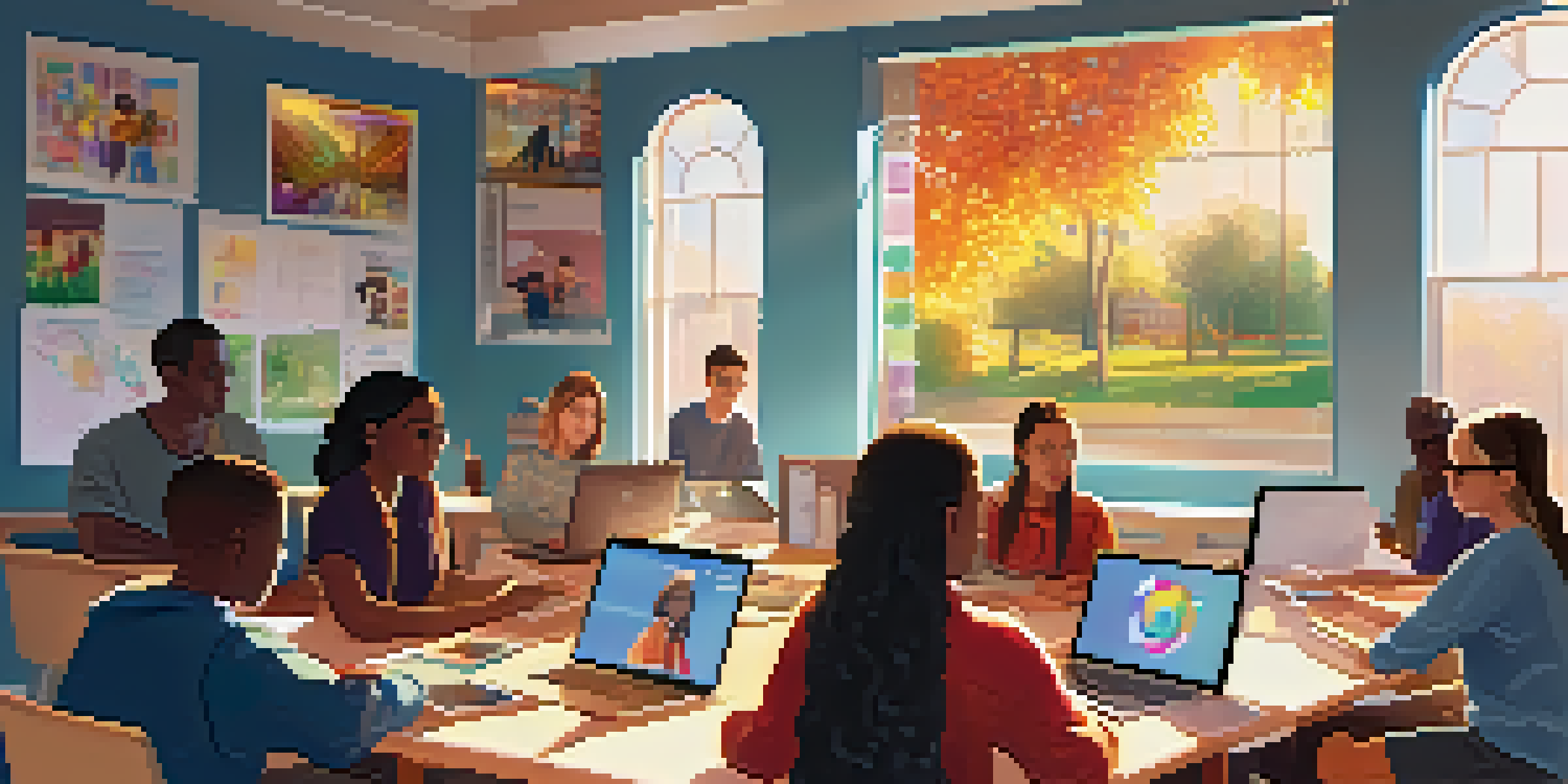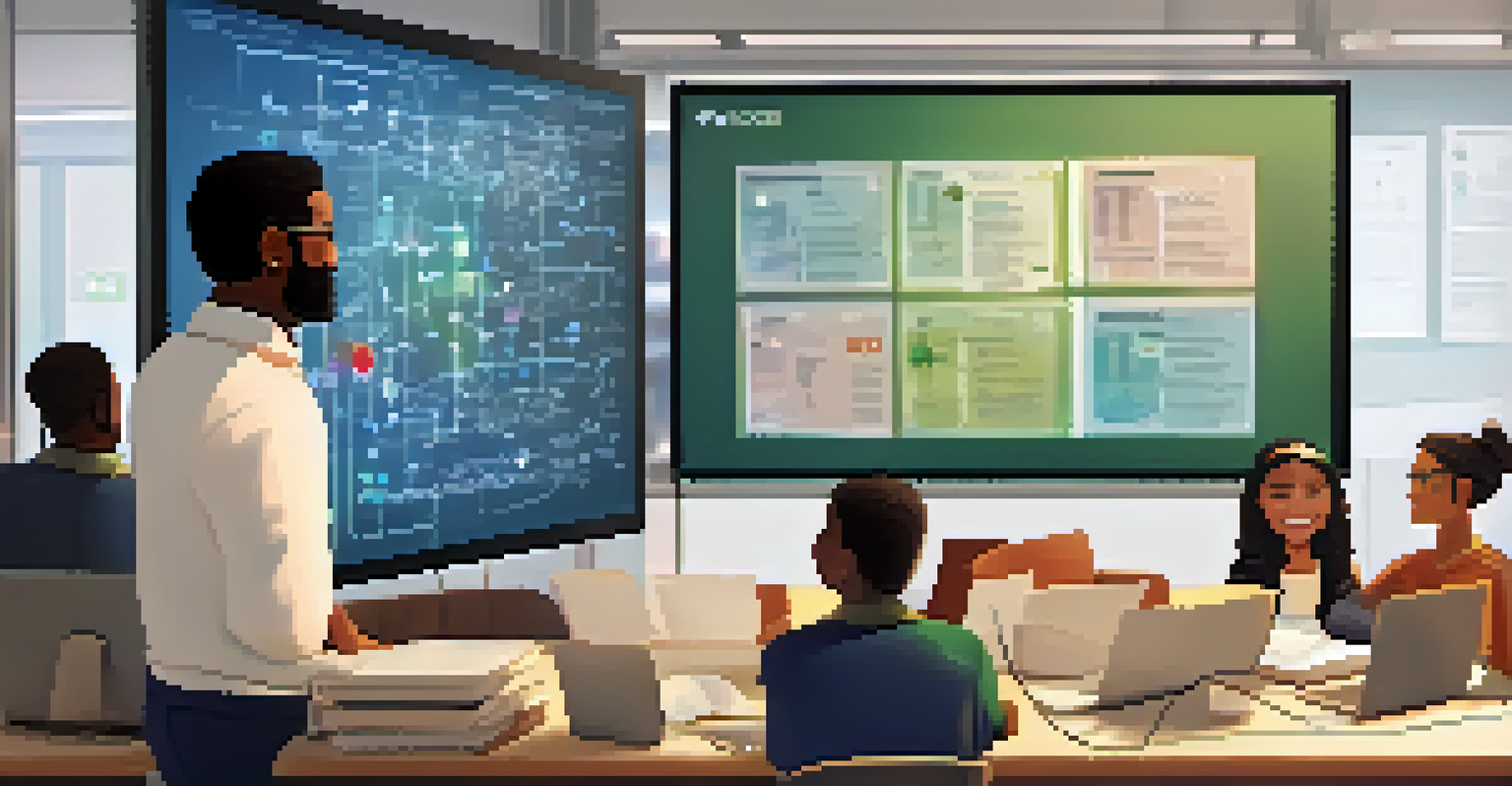The Benefits of Real-Time Collaboration in Online Education

Understanding Real-Time Collaboration in Online Education
Real-time collaboration refers to the ability for students and educators to interact instantaneously, regardless of their physical locations. This technology allows for a dynamic exchange of ideas, fostering a sense of community and engagement in online classrooms. Imagine a virtual space where students can raise their hands, share screens, and contribute to discussions just like in a traditional classroom.
Collaboration allows us to know more than we are capable of knowing by ourselves.
One of the key features of real-time collaboration is the use of tools like video conferencing, live chat, and collaborative documents. These tools enable participants to work on projects simultaneously, making learning more interactive and effective. It’s like having a study group right at your fingertips, where everyone can contribute in real-time.
As online education continues to evolve, integrating real-time collaboration tools has become essential. It not only enhances the learning experience but also prepares students for future work environments where teamwork and communication are crucial.
Enhancing Student Engagement Through Collaboration
When students collaborate in real-time, they are more likely to stay engaged and motivated throughout their learning journey. The immediacy of interaction keeps the discussions lively and encourages participants to share their thoughts without hesitation. This environment mimics a traditional classroom, where spontaneous ideas and questions can lead to deeper understanding.

Additionally, real-time collaboration can break down barriers that often inhibit participation. Students who may feel shy or hesitant in face-to-face settings may find it easier to express themselves online. This inclusivity fosters a richer exchange of ideas and perspectives, benefiting everyone involved.
Real-Time Collaboration Boosts Engagement
Instant interaction in online education keeps students motivated and involved in their learning.
By participating in collaborative activities, students also develop essential skills like communication, teamwork, and problem-solving. These skills are not only vital for academic success but also for future careers, as employers increasingly value collaboration in the workplace.
Facilitating Instant Feedback and Support
One of the standout benefits of real-time collaboration is the ability to receive instant feedback from peers and instructors. When working on assignments or projects, students can ask questions and get immediate responses, which can clarify doubts and enhance understanding. This timely feedback loop is crucial for effective learning.
Alone we can do so little; together we can do so much.
Moreover, real-time collaboration allows instructors to monitor student progress more closely. They can identify who is struggling and offer support right away, rather than waiting for the next scheduled class. This proactive approach can significantly improve student outcomes and satisfaction.
In essence, the immediacy of feedback creates a supportive learning environment where students feel valued and encouraged to ask for help when needed. It transforms the learning process from a solitary experience into a communal journey.
Building a Sense of Community Among Learners
Another major advantage of real-time collaboration is the community it fosters among learners. Students who participate in collaborative activities often feel a stronger connection to their peers, which can lead to lasting friendships and professional networks. This sense of belonging is particularly important in online education, where feelings of isolation can be common.
Through group discussions, collaborative projects, and peer reviews, students can engage with each other, share experiences, and support one another. These interactions enrich the learning experience, making it more enjoyable and rewarding. Think of it as a virtual coffee break where ideas flow freely and connections are made.
Fosters Community and Diverse Perspectives
Collaborative activities create a sense of belonging and enrich discussions through diverse viewpoints.
Ultimately, a strong community not only enhances educational outcomes but also prepares students for collaborative work environments they will encounter in their careers.
Encouraging Diverse Perspectives in Learning
Real-time collaboration brings together students from various backgrounds, cultures, and experiences, which can enrich discussions and learning outcomes. Exposure to diverse perspectives encourages critical thinking and helps students view topics from different angles. This diversity can lead to more innovative solutions and ideas in collaborative projects.
When students collaborate in real-time, they are not just learning from their instructors; they are learning from each other. This peer-to-peer interaction allows for a broader exchange of knowledge and insights, making the learning experience more comprehensive. It’s like having a global classroom, where every voice adds value.
Ultimately, embracing diverse perspectives in real-time collaboration prepares students for a world that values inclusivity and diversity, fostering a more empathetic and well-rounded approach to learning.
Boosting Accountability and Motivation
Real-time collaboration helps boost accountability among students. When working in groups, individuals are often more motivated to contribute and stay on task, knowing that their peers are relying on them. This shared responsibility can lead to higher levels of engagement and commitment to the learning process.
Additionally, seeing others actively participate can inspire students to bring their best selves to the table. The energy and enthusiasm generated in real-time collaborations can be contagious, motivating everyone to put forth their best effort. It’s like being part of a sports team where each member’s performance impacts the overall success.
Prepares Students for Future Careers
Real-time collaboration equips students with essential teamwork and communication skills for the modern workplace.
By fostering a sense of accountability, real-time collaboration not only enhances individual performance but also strengthens the collective outcomes of the group, leading to a more successful learning experience.
Adapting Learning Styles Through Collaboration
One of the remarkable aspects of real-time collaboration is its ability to cater to different learning styles. Whether a student learns best through visual aids, auditory discussions, or hands-on activities, real-time collaboration allows for a mix of approaches. This flexibility helps ensure that every student can engage in a way that suits them best.
For example, a student who prefers visual learning can share a presentation while others discuss it in real-time. Meanwhile, those who learn better by listening can absorb information through discussions, creating a rich tapestry of learning experiences. This adaptability makes online education more inclusive and effective.

In this way, real-time collaboration not only accommodates various learning preferences but also encourages students to explore and expand their own styles, leading to a more enriching educational experience.
Preparing Students for Future Work Environments
Finally, one of the most significant benefits of real-time collaboration in online education is its preparation for the future workforce. In an era where remote work and digital communication are becoming the norm, students equipped with collaborative skills will have a competitive edge. Real-time collaboration simulates the modern workplace, where teamwork and effective communication are critical.
As students engage in collaborative projects, they learn to navigate challenges, resolve conflicts, and develop interpersonal skills that will serve them well in their careers. It’s like a dress rehearsal for the professional world, where teamwork and collaboration are essential.
By emphasizing real-time collaboration in online education, we are not just teaching students academic content; we are preparing them for success in a rapidly changing job market.